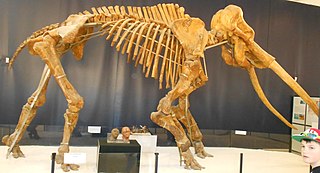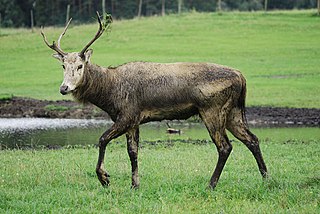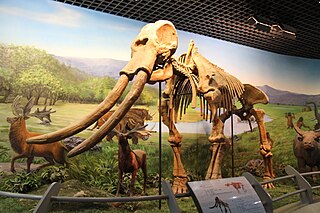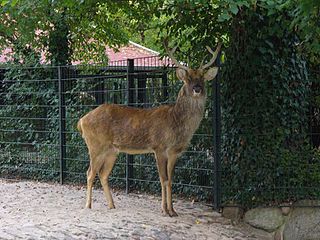
A deer or true deer is a hoofed ruminant ungulate of the family Cervidae. It is divided into subfamilies Cervinae and Capreolinae. Male deer of almost all species, as well as female reindeer, grow and shed new antlers each year. These antlers are bony extensions of the skull and are often used for combat between males.

The Irish elk, also called the giant deer or Irish deer, is an extinct species of deer in the genus Megaloceros and is one of the largest deer that ever lived. Its range extended across Eurasia during the Pleistocene, from Ireland to Lake Baikal in Siberia. The most recent remains of the species have been radiocarbon dated to about 7,700 years ago in western Russia. Its antlers, which can span 3.5 metres (11 ft) across are the largest known of any deer. It is not closely related to either living species called the elk, with it being widely agreed that its closest living relatives are fallow deer (Dama).

Megaloceros is an extinct genus of deer whose members lived throughout Eurasia from the Pleistocene to the early Holocene. The type and only undisputed member of the genus, Megaloceros giganteus, vernacularly known as the "Irish elk" or "giant deer", is also the best known. Fallow deer are thought to be their closest living relatives. Megaloceros is thought to be closely related to the East Asian genus Sinomegaceros, as well as possibly other extinct genera of "giant deer".

Palaeoloxodon is an extinct genus of elephant. The genus originated in Africa during the Early Pleistocene, and expanded into Eurasia at the beginning of the Middle Pleistocene. The genus contains some of the largest known species of elephants, over 4 metres (13 ft) tall at the shoulders, including the African Palaeoloxodon recki, the European straight-tusked elephant and the South Asian Palaeoloxodon namadicus. P. namadicus has been suggested to be the largest known land mammal by some authors based on extrapolation from fragmentary remains, though these estimates are highly speculative. In contrast, the genus also contains many species of dwarf elephants that evolved via insular dwarfism on islands in the Mediterranean, some only 1 metre (3.3 ft) in height, making them the smallest elephants known. The genus has a long and complex taxonomic history, and at various times, it has been considered to belong to Loxodonta or Elephas, but today is usually considered a valid and separate genus in its own right.

Stegodon is an extinct genus of proboscidean, related to elephants. It was originally assigned to the family Elephantidae along with modern elephants but is now placed in the extinct family Stegodontidae. Like elephants, Stegodon had teeth with plate-like lophs that are different from those of more primitive proboscideans like gomphotheres and mammutids. The oldest fossils of the genus are found in Late Miocene strata in Asia, likely originating from the more archaic Stegolophodon, subsequently migrating into Africa. While the genus became extinct in Africa during the Pliocene, Stegodon remained widespread in South, Southeast and East Asia until the end of the Pleistocene.

Lantian Man, Homo erectus lantianensis) is a subspecies of Homo erectus known from an almost complete mandible from Chenchiawo (陈家窝) Village discovered in 1963, and a partial skull from Gongwangling (公王岭) Village discovered in 1964, situated in Lantian County on the Loess Plateau. The former dates to about 710–684 thousand years ago, and the latter 1.65–1.59 million years ago. This makes Lantian Man the second-oldest firmly dated H. erectus beyond Africa, and the oldest in East Asia. The fossils were first described by Woo Ju-Kan in 1964, who considered the subspecies an ancestor to Peking Man.

The straight-tusked elephant is an extinct species of elephant that inhabited Europe and Western Asia during the Middle and Late Pleistocene. It was larger than any living elephant, with adult males suggested to reach 3.81–4.2 metres (12.5–13.8 ft) in shoulder height, and 11.3–15 tonnes in weight. Like modern elephants, the straight-tusked elephant lived in herds, flourishing during interglacial periods, when its range would extend as far north as Great Britain. Skeletons found in association with stone tools and wooden spears suggest they were scavenged and hunted by early humans, including Neanderthals. It is the ancestral species of most dwarf elephants that inhabited islands in the Mediterranean.

Mammuthus trogontherii, sometimes called the steppe mammoth, is an extinct species of mammoth that ranged over most of northern Eurasia during the Early and Middle Pleistocene, approximately 1.7 million-200,000 years ago. One of the largest mammoth species, it evolved in East Asia during the Early Pleistocene, around 1.8 million years ago, before migrating into North America around 1.5 million years ago, and into Europe during the Early/Middle Pleistocene transition, around 1 to 0.7 million years ago. It was the ancestor of the woolly mammoth and Columbian mammoth of the later Pleistocene.

The Cervinae or the Old World deer, are a subfamily of deer. Alternatively, they are known as the plesiometacarpal deer, due to having lost the parts of the second and fifth metacarpal bones closest to the foot, distinct from the telemetacarpal deer of the Capreolinae.

Elaphurus is a genus of deer. E.davidianus is the only extant species and several fossil species are described.

Leptobos is an extinct genus of large bovine, known from the Late Pliocene and Early Pleistocene of Eurasia, extending from the Iberian Peninsula to northern China. Species of Leptobos weighed on average 320 kilograms (710 lb). The dietary preference across the genus includes species that were browsers, grazers and mixed feeders. The first appearance of Leptobos in Europe around 3.6-3.5 million years ago is considered to define the beginning of the Villafranchian European faunal stage. Leptobos is considered to be closely related to the insular genus Epileptobos from the Pleistocene of Java, and is considered to be ancestral to Bison. Leptobos became extinct after being replaced by their descendant Bison during the Early Pleistocene, after a period of temporal overlap. "Leptobos" syrticus from Libya likely belongs in a different genus.

Pachyostosis is a non-pathological condition in vertebrate animals in which the bones experience a thickening, generally caused by extra layers of lamellar bone. It often occurs together with bone densification (osteosclerosis), reducing inner cavities. This joint occurrence is called pachyosteosclerosis. However, especially in the older literature, "pachyostosis" is often used loosely, referring to all osseous specializations characterized by an increase in bone compactness and/or volume. It occurs in both terrestrial and, especially, aquatic or semi-aquatic vertebrates.

Palaeoloxodon naumanni, occasionally called Naumann's elephant, is an extinct species belonging to the genus Palaeoloxodon found in the Japanese archipelago during the Middle to Late Pleistocene around 330,000 to 24,000 years ago. It is named after Heinrich Edmund Naumann who discovered the first fossils at Yokosuka, Kanagawa, Japan. Fossils attributed to P. naumanni are also known from China and Korea, though the status of these specimens is unresolved, and some authors regard them as belonging to separate species.

Rucervus is a genus of deer from India, Nepal, Indochina, and the Chinese island of Hainan. The only extant representatives, the barasingha or swamp deer and Eld's deer, are threatened by habitat loss and hunting; another species, Schomburgk’s deer, went extinct in 1938. Deer species found within the genus Rucervus are characterized by a specific antler structure, where the basal ramification is often supplemented with an additional small prong, and the middle tine is never present. The crown tines are inserted on the posterior side of the beam and may be bifurcated or fused into a small palmation.

Cervalces latifrons, the broad-fronted moose, or the giant moose was a giant species of deer that inhabited the Europe and Asia during the Pleistocene epoch. It is thought to be the ancestor of the modern moose, as well as the extinct North American Cervalces scotti. It was considerably larger than living moose, placing it as one of the largest deer to have ever lived.

Praemegaceros is an extinct genus of deer, known from the Pleistocene and Holocene of Western Eurasia. It contains the subgenera Praemegaceros,Orthogonoceros and Nesoleipoceros. It has sometimes been synonymised with Megaloceros and Megaceroides, however they have been found to be generically distinct.

Megaceroides algericus is an extinct species of deer known from the Late Pleistocene to the Holocene of North Africa. It is one of only two species of deer known to have been native to the African continent, alongside the Barbary stag, a subspecies of red deer. It is considered to be closely related to the giant deer species of Eurasia.
Camelus knoblochi is an extinct species of camel from the Pleistocene. One of the largest known camel species, its range spanned from Eastern Europe to Northern China.
Shikama Tokio (鹿間時夫) (1912–1978) was a Japanese vertebrate palaeontologist. Considered the leading Japanese figure in the field in the immediate pre- and post-war years, species he described include Yabe's giant deer.


















